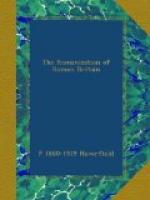[Footnote 3: I may record here a protest against the attempts made from time to time to dispossess the term ‘Samian’. Nothing better has been suggested in its stead, and the word itself has the merit of perfect lucidity. Of the various substitutes suggested, ‘Pseudo-Arretine’ is clumsy, ‘Terra Sigillata’ is at least as incorrect, and ‘Gaulish’ covers only a part of the field (Proc. Soc. Antiq. Lond., xxiii. 120).]
[Illustration: FIG. 19. ‘DRAGON-BROOCHES’ FOUND AT CORBRIDGE (1/1). (P. 44.)]
The contrast between this Romano-British civilization and the native culture which preceded it can readily be seen if we compare for a moment a Celtic village and a Romano-British village. Examples of each have been excavated in the south-west of England, hardly thirty miles apart. The Celtic village is close to Glastonbury in Somerset. Of itself it is a small, poor place—just a group of pile dwellings rising out of a marsh, or (as it may then have been) a lake, and dating from the two centuries immediately preceding the Christian era.[1] Yet, poor as it was, its art is distinct. There one recognizes all that general delight in decoration and that genuine artistic instinct which mark Late Celtic work, while the technical details of the ornament, as, for example, the returning spiral, reveal their affinity with the same native fashion. On the other hand, no trace of classical workmanship or design intrudes. There has not been found anywhere in the village even a fibula with a hinge instead of a spring, or of an Italian (as opposed to a Late Celtic) pattern. Turn now to the Romano-British villages excavated by General Pitt-Rivers at Woodcuts and Rotherley and Woodyates, eleven miles south-west of Salisbury, near the Roman road from Old Sarum (Sorbiodunum) to Dorchester in Dorset.[2] Here you may search in vain for vestiges of the native art or of that delight in artistic ornament which characterizes it. Everywhere the monotonous Roman culture meets the eye. To pass from Glastonbury to Woodcuts is like passing from some old timbered village of Kent or Sussex to the uniform streets of a modern city suburb. Life at Woodcuts had, no doubt, its barbaric side. One writer who has discussed its character with a view to the present problem[3] comments, with evident distaste, on ’dwellings connected with pits used as storage rooms, refuse sinks, and burial places’ and ‘corpses crouching in un-Roman positions’. The first feature is not without its parallels in modern countries and it was doubtless common in ancient Italy. The second would be more significant if such skeletons occupied all or even the majority of the graves in these villages. Neither feature really mars the broad result, that the material life was Roman. Perhaps the villagers knew little enough of the Roman civilization in its higher aspects. Perhaps they did not speak Latin fluently or habitually. They may well have counted among the less Romanized of the southern Britons. Yet round them too hung the heavy inevitable atmosphere of the Roman material civilization.




